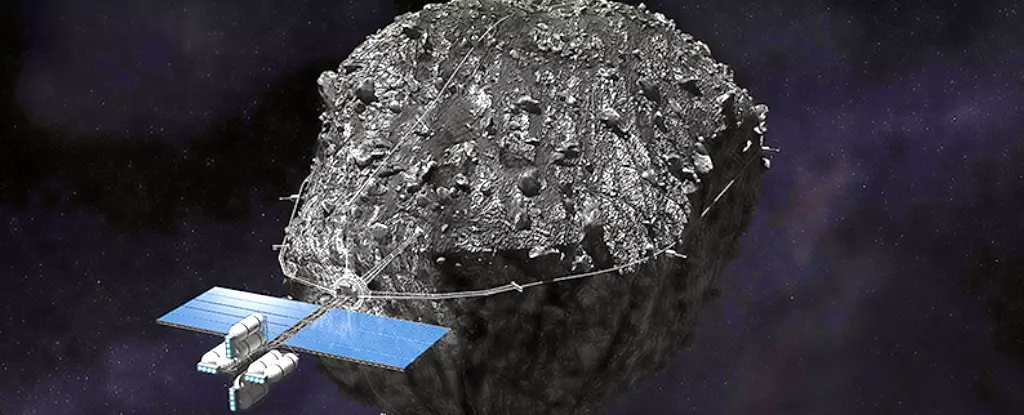Asteroid mining has captured the imaginations of scientists, entrepreneurs, and the general public alike. Media coverage often sensationalizes the potential worth of celestial bodies, suggesting that missions to asteroids like Psyche—believed to be rich in metals—could unlock a treasure trove worth an astonishing $10 quintillion. But how realistic are these claims, and what concrete value do these asteroids hold? A recent study funded by Astroforge, an asteroid mining startup, sheds light on this complex issue, rigorously analyzing the types of metals we might find and their potential worth.
The study categorizes the metals found in asteroids into two primary groups: those economically viable for return to Earth and those suitable primarily for in-space applications. Platinum-group metals (PGMs)—notably used in a range of high-tech applications including catalytic converters—fall into the first category. Their scarcity and high market value make them lucrative targets for mining ventures.
Conversely, metals like iron, aluminum, and magnesium represent the second category. Although these metals are plentiful in asteroids, their low value on Earth’s market makes transporting them back to Earth economically impractical. However, they hold significant potential for in-space construction, which could eventually support large-scale projects such as space stations and solar power arrays. Despite their utility, the fundamental challenge is the absence of an immediate market demand for these in-space metals, complicating efforts to assign them a credible monetary value.
One striking aspect of asteroid mining is the economic conundrum it faces—commonly likened to a “chicken and egg” problem. Launching materials from Earth incurs costs that range dramatically: approximately $10,000 per kilogram for general cargo and around $500,000 per kilogram for PGMs like rhodium. Although the latter figure appears exorbitant, it raises questions about the feasibility of asteroids as resource providers. If in-space demand materializes sufficiently, even more abundant metals could become economically viable to extract.
The exploration of these economic dynamics necessitates a sober analysis of both market conditions and technological advancements. As companies like Astroforge prepare for upcoming missions to assess the asteroids’ metallic content, the feasibility of mass extraction and its influence on Earth-bound markets remain uncertain.
Recent research challenges the assumption that asteroids composed primarily of pure metals are a common occurrence. Many are likely not the wealth-laden rocks that previous estimates suggested. While this discovery may initially sound disappointing for proponents of asteroid mining, the reality is more nuanced. The study uncovers that even asteroids previously thought to be metal-poor may still contain significant amounts of valuable materials.
Based on meteorite analyses, the researchers examined the elemental composition of 83 different metals sourced from remnants of asteroids. These meteorites serve as a critical analog for understanding the makeup of larger asteroids, especially given current technological limitations in remote sensing. The findings reveal that while PGMs may be less concentrated than once believed, they still appear in quantities that could be economically extracted, particularly from certain types of asteroids, such as L-types, which are less common and rich in refractory metal nuggets (RMNs).
However, extracting these metals is no simple task. The small size of RMNs presents significant operational hurdles, as they are typically micron to sub-micron in scale. This fine extraction process complicates the bulk mining of asteroidal materials, which can yield only hundreds of parts per million of valuable content.
Additionally, the physical state of these metals introduces another layer of challenge. The elements are often found in oxidized states and require high-energy extraction techniques, such as molten regolith electrolysis, to convert them into usable metallic forms. This high energy demand adds another level of complexity to the mining strategy, particularly because the technology to generate such power must itself be derived from materials that would require the very power source it seeks to operate.
The pathway to unlocking asteroid mining potential lies in both technological advancement and collaborative exploration. Initial missions, such as those planned by Astroforge, aim to gather crucial information about the compositions of these asteroids, providing essential insights that may shape future endeavors. While these missions are fraught with uncertainty, they promise to contribute significantly to a growing understanding of the resources available in our cosmic neighborhood.
The age of asteroid mining, if it becomes a reality, will not only require robust technological infrastructure but also a comprehensive understanding of economic viability and market dynamics. As research continues, the allure of asteroids may transform from a distant fantasy into an achievable frontier—one that could redefine our approach to resource utilization in space and on Earth alike.

